African Bee-eaters
Bee-eaters have their own family Meropidae in the order CORACIIFORMES, where they are placed alongside rollers, kingfishers, motmots and todies - the actual taxonomic sequence of which varies depending on the listing that’s being used.
Most authorities, including IOC (see footnote), now formally recognise 27 separate species of bee-eater under three genera - Nyctyornis and Meropogon for just three particular types of Asian bearded bee-eaters, and the main genus Merops for all the remaining species. Of these, a further three varieties are also restricted to Asia and one, the Rainbow Bee-eater, to Australia.
This leaves 20 species that can be regarded as African bee-eaters.
Featured species listed in taxonomic order :
I've now photographed a fair number of these beautiful birds during our various trips to Africa and, although there will always be species such as the Black-headed and Somali Bee-eater that are unlikely to ever find their way onto my list, I’m pretty pleased with what I've seen so far. This is particularly true when you consider that most of the time we’re on safari the primary focus is on animals. Obviously trying to photograph small birds from a vehicle isn't ideal, but occasionally you'll have a chance encounter and an opportunity to grab a few shots. However, because we've also seen bee-eaters when we haven't been restricted to a vehicle, notably when we were in the Gambia, and during our last trip to the Seychelles, it increases the list of destinations and indeed the varieties. I’ve also enjoyed some good sessions at nesting colonies, which has afforded more time for both observing behaviour and for getting images that you simply wouldn’t be able to achieve from a safari vehicle. And, of course, more time spent with a subject obviously results in more photos being taken. If I was putting together a portfolio of images, rather than selecting just one or two shots of a species, I wouldn't have any problem in coming up with a number of varied pictures of Red-throated, Blue-cheeked and Southern Carmine. But, as I move through the list, and start looking at some of the birds I've only encountered once, or twice at most, namely the White-throated, Swallow-tailed and Böhms Bee-eaters, I would struggle. In fact, the few photos I have the Swallow-tailed Bee-eater are, quite frankly, no more than 'record shots' and, as such, that species is not being featured in this write-up.
Before I started photographing and reading up about bee-eaters I assumed that, whilst there were different regional varieties, their habitat and behaviour would be similar. That isn’t the case as, just looking at the nine species I’ve included in this article, you’ll see that they can be found in a wide range of habitat from the arid sub-Saharan Sahel region, down through the rainforests and onto the open savannas, and even on the beaches of an Indian Ocean island. Some are regarded as resident or sedentary species, whereas others are breeding or non-breeding visitors. And, whilst most species nest in colonies, others will nest alone. Similar variations occur with the way they feed and even the type of bee, or indeed other insect, that they normally prey on.
Little Bee-eater [Merops pusillus]
The Little Bee-eater is one of the most common and widespread bird species in Africa, occurring throughout much of the sub-Saharan region except for heavily forested areas and deserts - their preferred habitat being grassy savannas and bushy open country. There are five recognised subspecies, of which I've seen and photographed two. The bird in the first photo is the nominate, ssp.pusillus, which is found across the central Sahel belt from The Gambia and Senegal in the west to Sudan in the east. In East Africa I've photographed ssp.meridionalis in both Tanzania and South Luangwa in northern Zambia
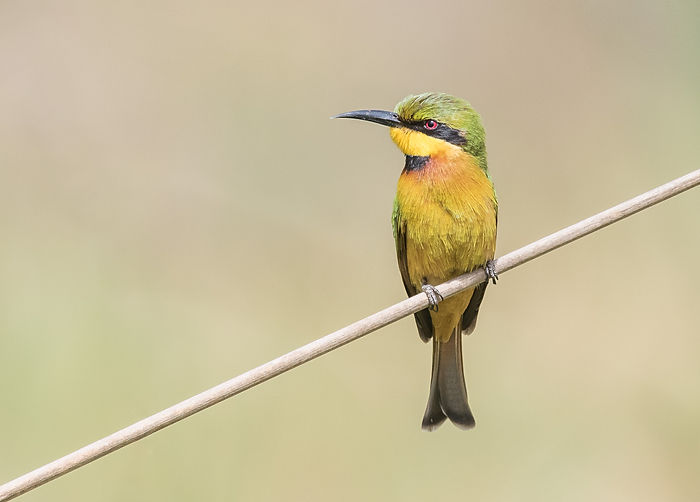
Little Bee-eater [Merops pusillus] | Kotu Rice Fields, Kombo North, The Gambia
At first glance these birds look the same, but on closer inspection you'll see a noticeable difference in respect of their facial markings as the East African race has a clearly visible blue superciliary stripe above the eye, which the nominate lacks. And, although it's not quite as clear, ssp.meridionalis has a thin, similarly coloured line between it's throat and gorget. The other subspecies have similar minor differences.

Little Bee-eater [Merops pusillus, ssp.meridionalis] | Ruaha NP, Tanzania
Red-throated Bee-eater [Merops bulocki]
Unlike most of the other bee-eater species, the Little Bee-eater is a solitary nester. A couple will pair up and stay together year round. They will breed, nest-build, hunt and feed as with a pair, but will gather with other birds at night for both safety and warmth when they will sleep bunched closely together on a suitable leafy twig. Little Bee-eaters often hunt from a low perch usually no more than a metre or so off the ground alongside bare ground, or alternatively from high in a tree if feeding in open grassland. As well as bees, they eat many other types of flying insect dependent on the habitat in which they're feeding. Whilst Little Bee-eaters do not migrate as such, they will move around in pursuit of water, which in turn makes their abundance within a given area quite seasonal, all subject to the weather and availability of insects.
The Red-throated Bee-eater is a species from the northern tropics with a range that stretches from Gambia and Senegal in the west across to Uganda, southern Sudan and Ethiopia in the east. There are two recognise subspecies - the nominate race, ssp.bulocki that's found in the western and more central areas of its range and ssp.frenatus that inhabits southern Sudan, western Ethiopia, northwest DR Congo and northern Uganda.
This species favours a habitat where there are bushy areas or lightly wooded savannas with small rivers or streams. They are highly sedentary, with individual birds seldom found more than a couple of miles from their nesting site.

Red-throated Bee-eater [Merops bulocki] | Wassu, Niani, The Gambia
White-fronted Bee-eater [Merops bullockoides]
The Red-throated Bee-eater is a colonial breeder that form their nests in suitable vertical banks of sand where they will dig new burrows every year, such that the cliff face becomes riddled over time with hundreds of holes, many of which will be unused. Whilst Red-throated Bee-eaters are strongly gregarious, which is a necessity of dense colonial living, they also indulge in a lot of neighbourly bickering when observed at their nesting holes. Like most bee-eaters, this species catches and eats a wide variety of flying insects apart from bees and wasps, including beetles, moths, butterflies, grasshoppers, crickets and dragonflies. However, their preferred and most frequent food source is the honeybee, which is believed to make up around a quarter of the bird's average intake.
Although I consider all bee-eaters to be lovely looking birds, I feel that this particular species is the most beautiful of all the varieties that I've been fortunate enough to have seen and photographed. We visited two nesting sites during our trip to The Gambia in 2018 - Bansang Quarry in Fuludu West and Wassu in Niani on the northern Senegal side of the river. My Flickr album (see the link at the bottom of the article) includes a few varied shots from these locations.
Whereas the Red-throated Bee-eater was a bird of the northern tropics, the closely related White-fronted Bee-eater is from the southern tropics with a range that stretches from Gabon and Angola in the west across to southwest Kenya and then south down through Tanzania, Zambia and Zimbabwe into southern Mozambique and northeast South Africa.
Their preferred habitat is much the same as the Red-throated variety including dry riverbeds and eroded gullies as those you'll often find in Zambia, but they will always be in an area where there are perennial rivers and seasonal streams with wooded banks.
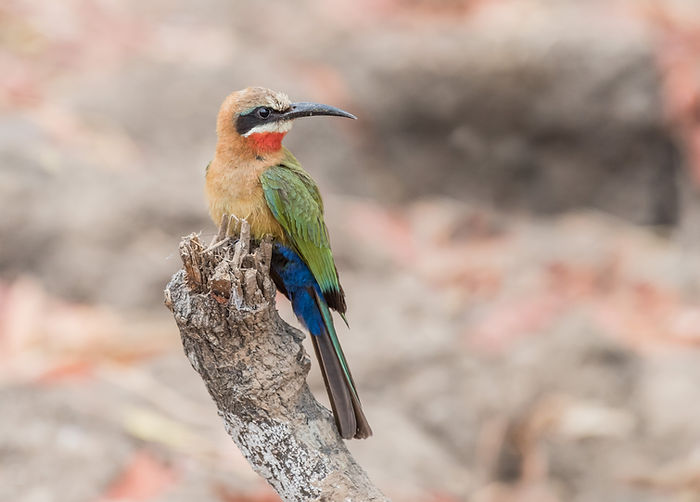
White-fronted Bee-eater [Merops bullockoides] | South Luangwa, Zambia
White-throated Bee-eater [Merops albicollis]
Whilst the White-fronted Bee-eater has no formally recognised subspecies, birds from southern Tanzania are slightly darker with their hindneck and belly washed with cinnamon - some authorities list this particular regional variant superficially as ssp.randorum. I have a rather nice picture of one of these birds, but the difference in colour isn't noticeable enough to warrant the inclusion of another photo.
The White-throated Bee-eater is unusual in that its breeding and winter habitats are so vastly different. In the summer they breed in the driest savanna and arid regions of the Sahel just south of the Sahara, and then in the winter migrate south to the rainforests.

White-throated Bee-eater [Merops albicollis] | Makasutu Forest, The Gambia
Böhm's Bee-eater [Merops boehmi]
Whilst most bee-eaters feed predominantly on bees and wasps, the White-throated Bee-eater's intake mainly consists of flying ants and flies.
The Böhm's, or Boehm's, Bee-eater has a restricted range that essentially confines it to just two particular regions of East Africa, thereby making it one of the most sought after species to photograph. The first area is between Lake Rukwa in Tanzania and the middle Kafue River in Zambia, and the other running from coastal Tanzania through Malawi to the Lower Zambezi.
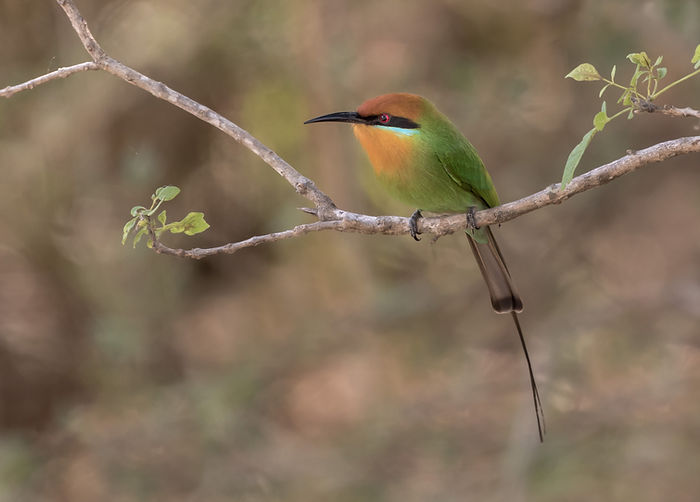
Böhm's Bee-eater [Merops boehmi] | Selous Game Reserve, Tanzania
Green Bee-eater [Merops orientalis]
Although Selous is one of the prime areas for seeing this species, I feel quite privileged to have had an opportunity of getting close enough in a safari vehicle in order to take the above photo. Our guide had spotted a pair of birds in a clump of trees just off the main track outside camp. We saw them on three separate occasions, but it was only on our last day that we managed to get a few shots of them in the open.
The Böhm's Bee-eater nests solitarily and monogamously without any helpers at the nest site as is usually the case with other bee-eater species.
The Green Bee-eater, previously known as the Little Green Bee-eater is one of the most widespread species with a range from Senegal and The Gambia in West Africa, across the continent in a narrow belt to the Red Sea, and beyond through Arabia into Asia as far east as Vietnam. Not surprisingly a number of subspecies are recognised across the bird's full range, two of which cover the African bee-eaters - the main race, ssp.viridissimus for all the birds found from Senegal to Ethiopia, and the localised varient form, ssp.cleopatra that populates the Nile Valley.

Green Bee-eater [Merops orientalis, ssp.viridissimus] | Boraba Forest, The Gambia
Blue-cheeked Bee-eater [Merops persicus]
Green Bee-eaters are resident and partially migrant in Africa, being found in the southern areas of their range in the drier months of October to April, and in the northern areas on the edge of the Sahara during the June to August wet season. The African birds have a preference for arid, sandy and gravelly areas with relatively sparse vegetation, whereas the species habitat is more diverse further east of its range. They are usually seen in small groups, but often roost communally in large night-time gatherings that could contain up to 300 birds.

Blue-cheeked Bee-eater [Merops persicus] | Ruaha NP, Tanzania
The Blue-cheeked Bee-eater breeds in areas of North Africa and across Asia from the Nile Delta to Rajasthan in northern India but, apart from a small population in the Sahel, is a migratory bird that winters in the African tropics. Both the bird in the following photo and those that have ended up in the Seychelles as the second image, are from Asia, and would normally arrive during late October or early November and depart by April in order to be back on their breeding grounds by the summer.
Whilst I've seen and photographed this species in both West and East Africa, my best encounters by far were during a trip to Bird Island in November 2016. We've visited this island many times, but always in October and although we'd heard that a few of these birds would invariably end up here for the winter, always favouring the wide open beach area at the north point of the island, we'd never seen them. My Flickr album (see the link at the bottom of the article) contains some nice pictures.
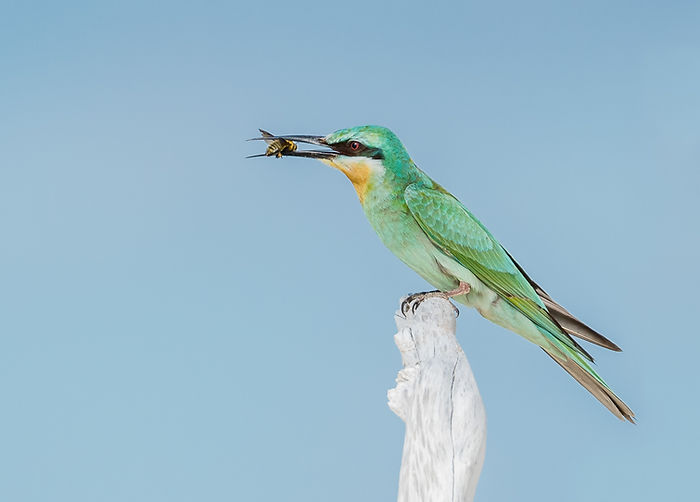
Blue-cheeked Bee-eater [Merops persicus] | Bird Island, Seychelles
European Bee-eater [Merops apiaster]
Although bees are a very important part of these species diet, dragonflies are actually their main food source. Obviously here on a remote Indian Ocean beach, hundreds of miles off the East African coast, they had to take whatever offerings were available, which were predominantly small bees. Despite the full tropical sun and 35 degree plus heat, I spent quite a few hours on the beach observing and photographing these birds. There were only eight birds as far as I could tell, which is about the same number as there normally are, but as I was watching them I started to appreciate just how many bees they were actually catching. This made me think as I've spent literally hundreds of hours on Bird Island over the years and have never been particularly conscious of bees flying around, so how could there be enough to satisfy these birds as they ned to catch such a large number of them every day? If you do the maths based on each bird eating a couple of hundred a day, which is normal, they would consume in excess of 200,000 between them if they stayed through to March. I still can't comprehend how that's possible, but those are the facts of the matter. The birds wouldn't be there unless there was food and given that they're unlikely to find dragonflies or many other flying insects, they would only be feeding on these small bees.
I suppose we should start with the question, "should the European Bee-eater be included in an article entitled African Bee-eaters?" - well, yes it should, because although the majority of birds breed in southern Europe, the species actually spends the greater part of the year in Africa. As well as Europe, the species also breeds in western Asia and parts of North Africa and, although rarely, in South Africa and Namibia. There are also records of birds breeding in northwest Europe and being seen as far north as Finland.
Notwithstanding those previous comments, the European Bee-eater is a strong migratory species, with all birds wintering exclusively in Africa, mainly between Lake Victoria and Transvaal, and west to Angola. Also, albeit less commonly, in a small area of West Africa from Sierra Leone to the Ivory Coast.
Despite being one of the most common and widespread bee-eater species, I don't actually have that many photos of them at present. In fact I've only encountered European Bee-eaters a few times - the first time was in Morocco in 2014, then a few times in Tanzania and, more recently in Extremadura in Spain where we sat and watched them at a roadside colony. Arguably the best photos were from Spain, but given that this article is specifically about African Bee-eaters I've used an image from Tanzania.

European Bee-eater [Merops apiaster] | Ruaha NP, Tanzania
Southern Carmine Bee-eater [Merops nubicoides]
What I like about this photo is that the bird is perched on a twig and not on a wire fence, and that was the downside in Spain as they were in an insect-rich pasture and farmland area where the fences around the fields were ideal for perching. Their preferred habitat is a warm open landscape with access to water and a good supply of insects and, in the breeding season, somewhere with sandy soil where they can nest. This makes central Spain ideal. We were there in May 2017 about four weeks or so after the birds arrived. They would be there for five months at most before making the long journey south back to Africa for the winter.
Previously considered a single species with a northern and southern race, the Carmine Bee-eater is now formally split into two separate species - the Northern Carmine [Merops nubicus] and the Southern Carmine [Merops nubicoides]. Unfortunately, I only had a fleeting glimpse of the northern variety when I was in The Gambia and don't have any photos to compare the two, but the difference is that it has a green-blue throat the same colour as its head, whereas the Southern Carmine Bee-eater's is a darker colouration of its pink body colour.
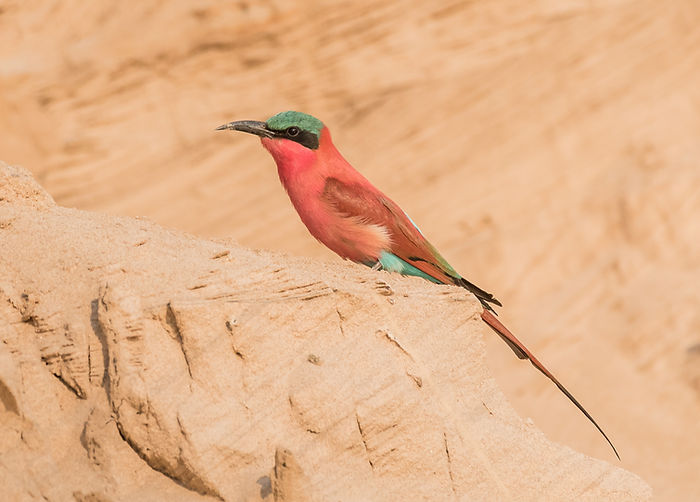
Southern Carmine Bee-eater [Merops nubicoides] | South Luangwa, Zambia
The Southern Carmine is found across sub-equatorial Africa from Uganda, south to Mozambique and Botswana, and west to Sudan. Between September to November they congregate in large numbers to nest, following which the birds distribute widely - the Luangwa Valley in Zambia is one of their main breeding areas.
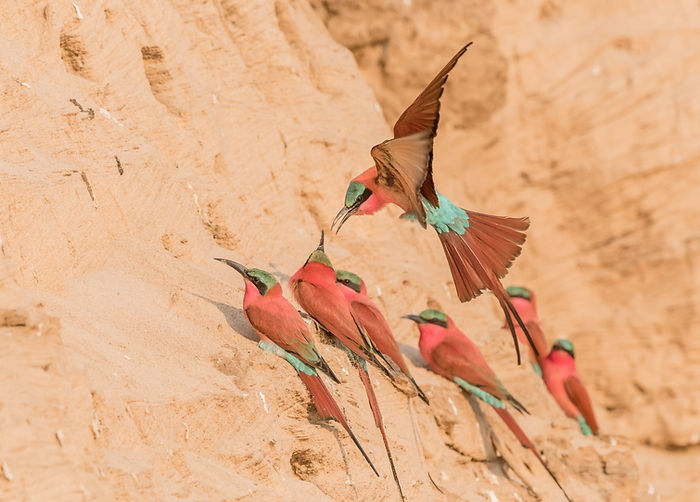
Southern Carmine Bee-eater [Merops nubicoides] | South Luangwa, Zambia
They return to the same nesting site, as they've been doing here on the the Luangwa River, year after year until the sandy bank is so riddled in old nesting holes that it starts to collapse. They will then just move to another area a little upstream or downstream of the same spot. Their tunnels are more or less straight and horizontal and are about 1-2m long and around 60mm in diameter. This particular nesting site is in a high, near vertical, sandy bank and is reputedly the only place in Africa where you can photograph the species from the comfort of a floating hide that is carefully moved into position and anchored mid-channel each September. If you get your timing right there can be a lot of activity at a nesting colony with birds continually coming and going. You'd think that would give you a lot of photographic opportunities, which in a way it does, but with so much happening it's not that straightforward, as getting clean shots of individual birds proved quite challenging. I'm glad we had the experience, but I would have been happier if the floating hide had been positioned a bit further away from the bank as that would have provided a far better chance of getting some decent flight shots.

Southern Carmine Bee-eater [Merops nubicoides] | South Luangwa, Zambia
It's not uncommon to witness minor disputes in the colony with so many birds occupying such a tightly packed nesting site, but I'm not so sure that was the case with the above pair and, whilst I didn't actually see an exchange, the body-language of these birds gave me the distinct impression that an item of food was being passed between them.
So that's it, a brief overview of nine of the ten species of African Bee-eater that I've been fortunate enough to have both seen and photographed. Realistically I do not see any more varieties being added to this list as the missing species are either very localised like the Böhm's, or are found in the central forest areas which I'm very unlikely to visit.
Footnote :
IOC refers to the regularly updated on-line IOC 'World Bird List', which should now be regarded as the go-to source for avian taxonomy in the UK, since it was formally adopted by the BOU (British Ornithological Union) at the beginning of 2018. In this case IOC stands for the International Ornithological Congress, not the International Olympic Committee.